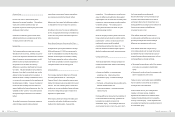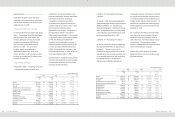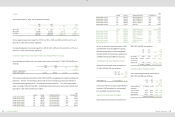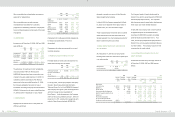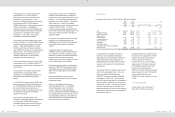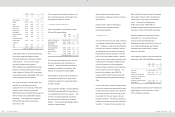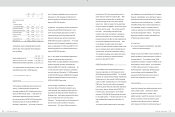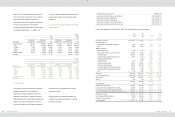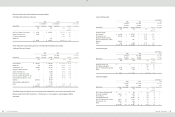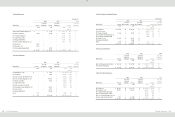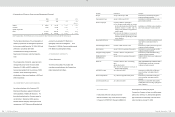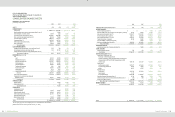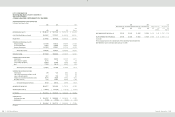HTC 2008 Annual Report Download - page 89
Download and view the complete annual report
Please find page 89 of the 2008 HTC annual report below. You can navigate through the pages in the report by either clicking on the pages listed below, or by using the keyword search tool below to find specific information within the annual report.
Financial Information
| 43
42 |
2008 Annual Report
The government enacted the Alternative Minimum
Tax Act (the “AMT Act”), which became effective on
January 1, 2006. The alternative minimum tax
(“AMT”) imposed under the AMT Act is a
supplemental tax levied at a rate of 10% which is
payable if the income tax payable determined
pursuant to the Income Tax Law is below the
minimum amount prescribed under the AMT Act.
The taxable income for calculating the AMT
includes most of the income that is exempted from
income tax under various laws and statutes. The
Company has considered the impact of the AMT
Act in the determination of its tax liabilities. As a
result, the current income tax payable as of
December 31, 2008 should be NT$3,396,417
thousand (US$103,549 thousand).
The tax effects of deductible temporary differences
and tax credit carryforwards that gave rise to
deferred tax assets as of December 31, 2006,
2007 and 2008 were as follows:
2006
2007
2008
NT$
NT$
NT$
US$
Temporary differences
(Note 3)
Provision for loss on decline in value of inventory
$
222,916
$
229,072
$
405,806
$
12,372
Unrealized marketing expenses
245,772
751,755
1,452,633
44,288
Unrealized reserve for warranty expense
348,499
867,489
1,306,466
39,831
Capitalized expense
31,936
39,628
58,190
1,774
Unrealized royalties
942,097
1,009,848
1,535,925
46,827
Unrealized bad-debt expenses
-
16,151
26,503
808
Unrealized value loss on financial instruments
19,117
24,064
128,521
3,918
Other
27,770
41,434
12,465
380
Tax credit carryforwards
-
-
2,196,808
66,976
Total deferred tax assets
1,838,107
2,979,441
7,123,317
217,174
Less: Valuation allowance
(
1,134,041
)
(
1,970,824
)
(
5,679,417
)
(
173,153
)
Total deferred tax assets, net
704,066
1,008,617
1,443,900
44,021
Deferred tax liabilities
Unrealized pension cost
(
18,505
)
(
23,797
)
(
29,284
)
(
893
)
Unrealized foreign exchange gain, net
(
38,254
)
(
42,710
)
(
40,978
)
(
1,249
)
647,307
942,110
1,373,638
41,879
Less: Current portion
(
428,077
)
(
562,025
)
(
552,494
)
(
16,844
)
Deferred tax assets - noncurrent
$
219,230
$
380,085
$
821,144
$
25,035
Details of the tax credit carryforwards were as follows:
Credit
2006
2007
2008
Grant Year
Validity Period
NT$
NT$
NT$
US$
(Note 3)
2007
2007-2011
$
-
$
-
$
201,506
$
6,144
2008
2008-2012
-
-
1,995,302
60,832
$
-
$
-
$
2,196,808
$
66,976
Based on the Income Tax Act of the ROC, the
investment and research and development tax
credits can be carried forward for four years.
The total credits used in each year cannot
exceed half of the estimated income tax
provision, except in the last year.
Valuation allowance is based on management’s
evaluation of the amount of tax credits that can
be carried forward for four years, based on the
Company’s financial forecasts.
The income taxes in 2006, 2007 and 2008 were as follows:
2006
2007
2008
NT$
NT$
NT$
US$
(Note 3)
Current income tax
$1,847,294
$3,381,327
$3,396,417
$103,549
Increase in deferred income tax assets
(168,447
)
(294,803
)
(431,528
)
(13,156
)
Underestimation (overestimation) of prior year’s income tax
31,704
125,911
(9,759
)
(297
)
Income tax
$1,710,551
$3,212,435
$2,955,130
$90,096
The integrated income tax information is as follows:
2006
2007
2008
NT$
NT$
NT$
US$
(Note 3)
Balance of imputation credit account (ICA)
$1,772,897
$3,005,386
$5,568,676
$169,777
Unappropriated earnings generated from 1998
31,991,090
41,403,867
44,626,182
1,360,555
Actual/estimated creditable ratio (including income tax payable)
5.54 % (actual ratio)
7.26% (actual ratio)
12.48%(estimatedratio)
12.48%(estimatedratio)
For distribution of earnings generated on or after
January 1, 1998, the ratio for the imputation credits
allocated to stockholders of the Company is based
on the balance of the ICA as of the date of dividend
distribution. The expected creditable ratio for the
2008 earnings may be adjusted, depending on the
ICA balance on the date of dividend distribution.
23.EARNINGS PER SHARE
Earnings per share (EPS) before tax and after tax
are calculated by dividing net income by the
weighted average number of common shares
outstanding which includes the deduction of the
effect of treasury stock during each year. The
weighted average number of shares used in EPS
calculation was 761,697 thousand shares, 755,608
thousand shares and 754,148 thousand shares for
the years ended December 31, 2006, 2007 and
2008, respectively. EPS for the years ended
December 31, 2006 and 2007 were calculated
the average number of shares outstanding was
adjusted retroactively for the effect of stock
dividend distribution in 2008.
The Accounting Research and Development
Foundation issued Interpretation 2007-052 that
requires companies to recognize bonuses paid to
employees, directors and supervisors as
compensation expenses beginning January 1,
2008. These bonuses were previously recorded
as appropriations from earnings. If the Company
may settle the bonus to employees by cash or
shares, the Company should presume that the
entire amount of the bonus will be settled in shares
and the resulting potential shares should be
included in the weighted average number of
shares outstanding used in the calculation of
diluted EPS, if the shares have a dilutive effect.
The number of shares is estimated by dividing the
entire amount of the bonus by the closing price of



